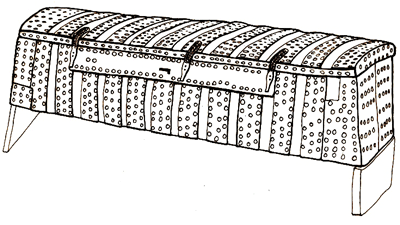Well, the school holidays wouldn't be the same without at least one project on the go.

The casket I've constructed here is based upon one that was found during the excavations of Hedeby.
Intriguingly, the original was found with it's lock plate missing and weighted down with a stone at a location that would have been the bottom of the harbour. I love the story that brings to mind and I've hankered for a Viking age chest with a plate lock for some time now so it was a natural choice for me.
I'm going to carve it up a bit, like I did with my Wayland Kista a while back and when it is finished I'll oil and tar it again so it will look a lot darker. The box section is made from oak planks and the lid is carved from a half trunk of Maple I think, it's been stained to blend it in a bit better with the box.

The casket I've constructed here is based upon one that was found during the excavations of Hedeby.
Intriguingly, the original was found with it's lock plate missing and weighted down with a stone at a location that would have been the bottom of the harbour. I love the story that brings to mind and I've hankered for a Viking age chest with a plate lock for some time now so it was a natural choice for me.
I'm going to carve it up a bit, like I did with my Wayland Kista a while back and when it is finished I'll oil and tar it again so it will look a lot darker. The box section is made from oak planks and the lid is carved from a half trunk of Maple I think, it's been stained to blend it in a bit better with the box.
Last edited:



